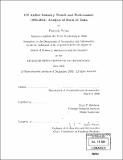| dc.contributor.advisor | Peter P. Belobaba. | en_US |
| dc.contributor.author | Strina François | en_US |
| dc.contributor.other | Massachusetts Institute of Technology. Dept. of Aeronautics and Astronautics. | en_US |
| dc.date.accessioned | 2007-01-10T16:39:06Z | |
| dc.date.available | 2007-01-10T16:39:06Z | |
| dc.date.copyright | 2006 | en_US |
| dc.date.issued | 2006 | en_US |
| dc.identifier.uri | http://hdl.handle.net/1721.1/35562 | |
| dc.description | Thesis (S.M.)--Massachusetts Institute of Technology, Dept. of Aeronautics and Astronautics, 2006. | en_US |
| dc.description | Includes bibliographical references (p. 115-116). | en_US |
| dc.description.abstract | Since 2001, the US airline industry has faced an unprecedented set of challenges. Following the terrorist attacks of September 11, 2001, the airline industry reported tremendous losses and several of the largest US airlines went into bankruptcy. To recover from this situation and try to remain financially viable, many measures have been taken by airlines. As a result, the airline industry has been a very dynamic industry over the last few years. The main objective of this thesis is to investigate the changes that occurred in this industry between 1999 and 2004. Only the performance of a subset of airlines, namely the 12 main passenger Majors, is examined. These 12 airlines are categorized into two subsets, the Legacies and the Lowfares, whose results are compared throughout this thesis. The analyses, that focus both on financial and operating conditions of the airlines, are mainly based on data from the Form 41 reports. This study shows that in 2004, the traffic carried by the 12 Majors was almost back to 2000 levels, with a higher portion carried by the Lowfares though. It also shows that on average, the Majors flew their aircraft further and that, because the capacity was more closely adjusted to the demand, these aircraft were operated with a higher load factor in 2004 than in 1999. | en_US |
| dc.description.abstract | (cont.) As regards the costs, this work reveals that, in spite of an overall increase in productivity - in labor, aircraft and fuel - the average unit cost increased for the Majors. In addition, the gap in unit cost between the Legacies and the Lowfares actually widened between 1999 and 2004, even though a significant part of this trend is due to a transfer of capacity to the regional airlines. Concerning the revenues, an overall decline of the yield is observed in this thesis, as well as a convergence of the yield of the two subsets of Majors. This analysis finally highlights the fact that, whereas Legacies have reported tremendous losses since 2001, most lowfare airlines were able to break-even or even make money in operations. | en_US |
| dc.description.statementofresponsibility | by François Strina. | en_US |
| dc.format.extent | 116 p. | en_US |
| dc.format.extent | 7675872 bytes | |
| dc.format.extent | 8086084 bytes | |
| dc.format.mimetype | application/pdf | |
| dc.format.mimetype | application/pdf | |
| dc.language.iso | eng | en_US |
| dc.publisher | Massachusetts Institute of Technology | en_US |
| dc.rights | M.I.T. theses are protected by copyright. They may be viewed from this source for any purpose, but reproduction or distribution in any format is prohibited without written permission. See provided URL for inquiries about permission. | en_US |
| dc.rights.uri | http://dspace.mit.edu/handle/1721.1/7582 | |
| dc.subject | Aeronautics and Astronautics. | en_US |
| dc.title | US airline industry trends and performance 1999-2004 : analysis of Form 41 data | en_US |
| dc.title.alternative | United States airline industry trends and performance 1999-2004 : analysis of Form 41 data | en_US |
| dc.type | Thesis | en_US |
| dc.description.degree | S.M. | en_US |
| dc.contributor.department | Massachusetts Institute of Technology. Department of Aeronautics and Astronautics | |
| dc.identifier.oclc | 73827201 | en_US |
